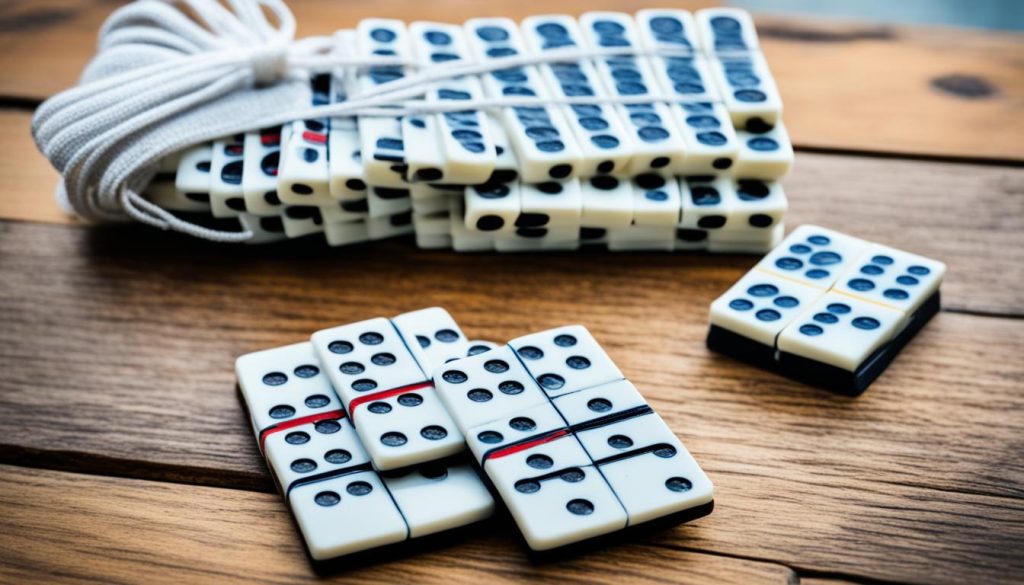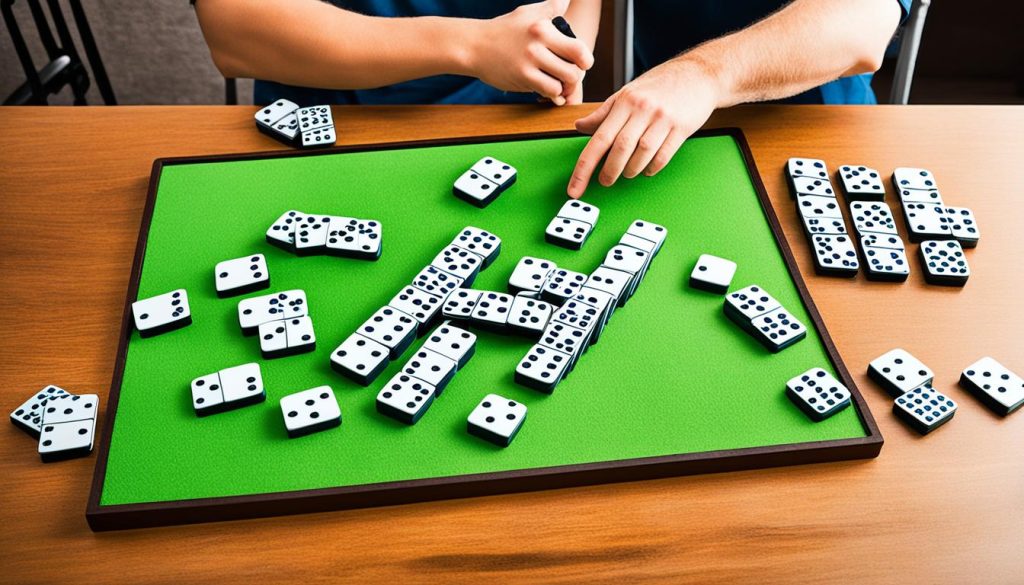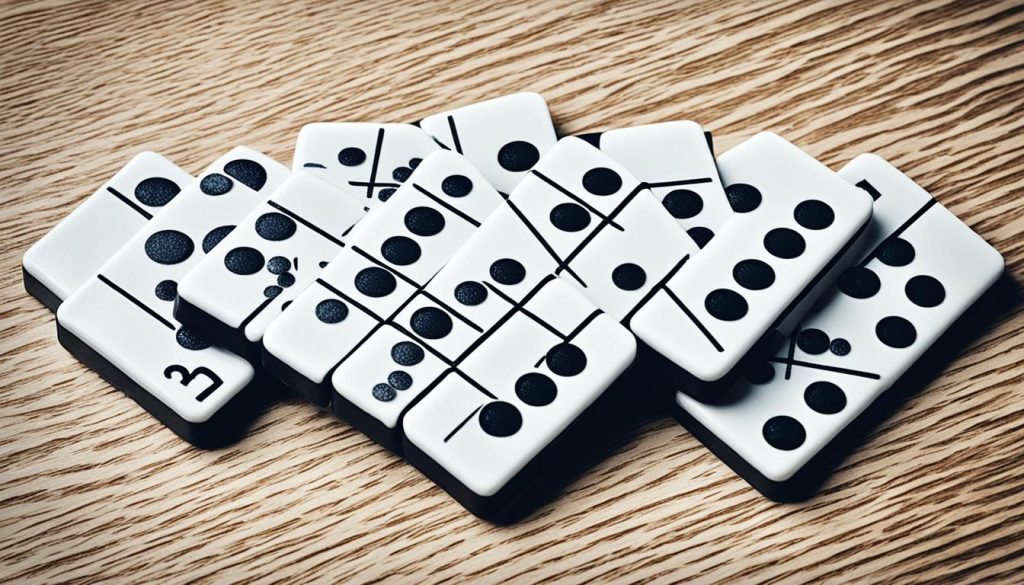Dominoes is a popular game played all around the world. It is a game of strategy and luck that can be played with two or more players. The objective of the game is to be the first player to empty your hand of all your tiles or to score the most points after a set number of rounds. In the article, we will explore the objectives of the game, the materials needed to play, how to play dominoes, the game setup, the gameplay itself, the scoring of the game, and various variations of dominoes. So, if you are ready to learn how to play dominoes, let’s get started!
Objectives of the Game
In a game of dominoes, the primary objective is to either be the first player to empty your hand of all your tiles or to score the most points after a set number of rounds. Players take turns placing tiles on the table, matching the pips on their tiles to those on the tiles already played.
The player who runs out of tiles first wins the round and scores points for the tiles left in their opponent’s hand. This combination of strategy and luck makes for an engaging and dynamic gameplay experience.
To better understand the gameplay and objectives of dominoes, let’s take a closer look at the rules and mechanics of this popular game.

| Objectives | Description |
|---|---|
| Empty hand | The first objective is to be the player who empties their hand of all their tiles first. This requires strategic placement of tiles and careful consideration of the available options on the table. |
| Score the most points | If none of the players are able to empty their hands, the objective shifts to scoring the most points. Points are scored based on the tiles left in the opponent’s hand at the end of each round. The player with the lowest total wins the round and earns points based on the pips left in their opponent’s hand. |
By understanding these objectives, players can develop strategies to achieve victory in dominoes. The game offers an intriguing blend of planning ahead, adapting to the changing board, and making the most of the tiles available.
Materials Needed to Play
To play dominoes, you will need a set of dominoes. A standard set contains 28 tiles, but larger sets with up to 91 tiles are also available. You will also need a flat surface to play on.
| Materials | Quantity |
|---|---|
| Dominoes set | 1 |
| Flat surface | 1 |
The dominoes set is the main requirement for playing the game. It consists of individual tiles with different combinations of pips or dots on each end. A standard domino set includes tiles numbered from 0-6, with duplicates for each number combination. The number of tiles in a set may vary depending on the variation of the game being played.
The flat surface provides a stable playing area where players can arrange their tiles and make moves during the game. A table or any flat and even surface can serve as a suitable playing area for dominoes.
Having the necessary materials ready will ensure that you can enjoy a game of dominoes with friends and family. Whether you’re a beginner or an experienced player, the right materials will set the foundation for an exciting and strategic gameplay experience.

Setting up the Game
To get started with a game of dominoes, it is essential to set up the game properly. Follow these instructions to ensure a smooth and enjoyable gameplay experience:
Shuffling and Placing the Tiles
First, shuffle the tiles face down, so that no one knows the order they are in. This ensures fairness and unpredictability in the game. Once shuffled, place the tiles on the table in a straight line, creating a domino chain.

Drawing Tiles
Next, each player will need to draw a certain number of tiles from the shuffled set. The number of tiles drawn depends on the number of players and the variation of the game being played. Typically, in a two-player game, each player would draw seven tiles, while in a game with three or four players, each player may draw fewer tiles to accommodate the larger number of players.
Familiarize Yourself with the Tiles
Before starting the game, take a moment to familiarize yourself with the tiles and their corresponding values. Each tile has two ends, with each end containing zero to six pips or dots. The number of pips on each end determines the value of the tile. For example, a tile with two pips on one end and four pips on the other end has a total value of six.
Now that the game has been set up, you are ready to begin playing dominoes. Refer to the next section, “How to Play the Game,” for detailed gameplay instructions.
How to Play Dominoes?
Playing dominoes is an exciting and strategic game that can be enjoyed by players of all skill levels. The gameplay revolves around matching the pips on your tiles to those already played on the table. Here is a step-by-step guide on how to play dominoes with different numbers of players.
Two Players
In a two-player game, each player starts with seven tiles. The player with the highest double tile goes first. If neither player has a double, the one with the highest total pip count on their tiles starts. Players take turns placing tiles on the table, and if a player cannot make a match, they must draw a tile from the stack until they can play. The game continues until one player runs out of tiles or until neither player can make a match. In this case, the player with the fewest remaining tiles wins.
Three Players
In a three-player game, each player starts with five tiles. The player with the highest double tile goes first. If no one has a double, the highest total pip count determines the starting player. The gameplay follows the same rules as in a two-player game, with players taking turns placing tiles on the table. The game ends when one player uses all their tiles or when none of the players can make a match. In the latter case, the player with the fewest remaining tiles wins.
Four Players
In a four-player game, each player starts with five tiles. The player with the highest double tile goes first, and if no one has a double, the starting player is determined by the highest total pip count. The gameplay proceeds in a clockwise direction. Each player takes turns placing tiles on the table, matching the pips to tiles already played. If a player cannot make a match, they must draw a tile from the stack until they can play. The game ends when one player uses all their tiles or when none of the players can make a match. The player with the fewest remaining tiles is declared the winner.
Remember, the strategy in dominoes comes from planning your moves and blocking your opponents’ plays. Consider the tiles in your hand, anticipate their moves, and strategically place your tiles to gain an advantage. Good luck and have fun!
Scoring the Game
In a game of dominoes, scoring takes place at the end of each round. It is based on the tiles left in the opponent’s hand. The player who successfully scores the lowest total wins the round and earns points equal to the total number of pips left in their opponent’s hand. This section will guide you through the scoring process in the game of dominoes.
Step 1: Counting Total Pips
First, count the total number of pips on the tiles in your opponent’s hand. Pips are the individual dots on each tile that represent their value. Take your time to carefully count each pip, ensuring accuracy in your calculations.
Step 2: Determining the Lowest Total
Compare the total number of pips in your opponent’s hand with your own. The player with the lowest total wins the round. For example, if your opponent has a total of 15 pips and you have 10 pips, you would win the round as your total is lower.
Step 3: Scoring Points
After determining the winner of the round, assign points based on the total number of pips left in the opponent’s hand. The player who won the round earns points equal to the total number of pips. For instance, if your opponent has 15 pips remaining in their hand, and you are the winner, you would receive 15 points for that round.
Step 4: Winning the Game
The game continues until one player reaches a predetermined set number of points, typically 100 or 200. The first player to achieve this target becomes the overall winner of the game.
By understanding the scoring process, you can keep track of your progress and strive to accumulate points to secure victory in the game of dominoes.

Variations of Dominoes
In addition to the classic version of dominoes, there are several exciting variations of the game that offer unique gameplay experiences. Whether you’re looking for a different strategy, a new challenge, or simply want to switch things up, exploring these variations is a great way to enhance your dominoes skills and keep the game interesting.
1. Block Dominoes
Block dominoes is a popular variation where the goal is to empty your hand of tiles by playing them strategically on the table. Each player takes turns placing tiles that match the open ends of the layout, or “block.” The game continues until one player runs out of tiles, or no one can make a legal play. At the end, the player with the fewest tiles remaining is the winner.
2. Mexican Train Dominoes
Mexican Train dominoes is a dynamic and social variation that requires strategy and planning. The objective is to play all your tiles onto your own “train,” while also contributing to a communal “Mexican Train.” Players may strategically block opponents or redirect the train to their benefit. The game ends when a player plays their last tile or everyone is blocked. The player with the lowest score wins.
3. All-Fives Dominoes
All-Fives dominoes is a fast-paced variation that focuses on scoring points based on the total number of pips on the tiles played. The objective is to make the open ends of the layout add up to a multiple of five. For each multiple of five achieved, the player scores points equal to the sum of the pips on the tiles played. The game continues until one player scores a predetermined number of points.
Exploring these variations of dominoes can bring new excitement and challenges to your gameplay. Each variation has its own set of rules and strategies, allowing you to further develop your dominoes skills and strategies. Whether you prefer the strategic depth of block dominoes, the social dynamics of Mexican Train dominoes, or the fast-paced scoring in All-Fives dominoes, there is a variation that suits your preferences. So, gather your friends, choose your favorite variation, and enjoy the thrill of the dominoes game!
Conclusion
Dominoes is a captivating game that provides endless entertainment for players of all ages. Whether you’re spending quality time with family or enjoying a competitive game night with friends, the rules and strategies outlined in this guide will help you become a skilled dominoes player.
Remember, the first step is to choose the right set of dominoes. Whether you opt for a standard 28-tile set or a larger variation, having the appropriate tiles is essential for a smooth gameplay experience.
Once you have your set, make sure to set up the game correctly by shuffling the tiles and placing them in a line on the playing surface. This will ensure a fair and balanced game for all players.
Lastly, understanding the scoring system is crucial to winning at dominoes. By keeping track of your opponent’s remaining tiles and strategically placing your own, you can maximize your chances of scoring points and ultimately emerging as the victor.
So why wait? Gather your friends, shuffle those tiles, and embark on a thrilling adventure into the world of dominoes. With practice and perseverance, you’ll master the game and create countless unforgettable memories.

